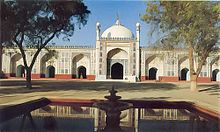What You Need To Know
Multan, is a city in Punjab, Pakistan. It is Pakistan’s 5th largest city by population and 3rd largest city by area. The city is located on the banks of the Chenab River Multan is also titled as the City of Sufis, City of Saints and Madinat-ul-Auliya because of the large number of shrines and Sufi saints from the city. The city is blanketed with bazaars, mosques, shrines, and ornate tombs. Multan is also famous for ancient Hindu temples, the most famous temple being Prahladpuri Temple. The Holi or Holika festival of the Hindus originated from this temple. Multan is also the birthplace of Fariduddin Ganjshakar (popularly known as “Baba Farid”), recognised as the first major poet of the Punjabi language. Multan is located in a bend created by five rivers of central Pakistan. The Sutlej River separates it from Bahawalpur and the Chenab River from Muzaffar Garh. One of the oldest cities in the world dating back 6000 years, the city has grown to become an influential political and economical centre for the country, with a dry port and excellent transport links. Multan is famous for its crops: wheat, cotton and sugar cane, mangoes, citrus, guavas, and pomegranates.
Area: 3,721 km²
Population: Estimate 1.4 Million
Currency
The Pakistani rupee (Urdu: روپیہ / ALA-LC: Rūpiyah; sign: ₨; code: PKR) is the currency of Pakistan.
Government
Administrators who are government servants have the powers of Nazims (Mayor). Multan district is spread over an area of 3,721 square kilometres (1,437 square miles), comprising four tehsils: Multan City, Multan Saddar, Shujabad and Jalalpur Pirwala.
Health
Healthcare in Pakistan is administered mainly in the private sector which accounts for approximately 80{240617086b89b49b35d59dcd9faac9628addde73d91df41d206a85bea752b461} of all outpatient visits. The public sector was until recently led by the Ministry of Health, however the Ministry was abolished in June 2011 and all health responsibilities (mainly planning and fund allocation) were devolved to provincial Health Departments which had until now been the main implementers of public sector health programs. Like other South Asian countries, health and sanitation infrastructure is adequate in urban areas but is generally poor in rural areas.
Language
Pakistan’s national language is Urdu, which, along with English, is also the official language. In 2015, the government of Pakistan announced plans to make Urdu the sole official language and abolish English as the second official language.
Mosques of Multan

Prahladpuri Temple

Prahladpuri Temple, Multan is located It is located on top of a raised platform inside the Fort of Multan, adjacent to tomb of Hazrat Baha’ul Haq Zakariya. The Prahladapuri temple like the Sun Temple of Multan had been destroyed after Muslim conquest of Multan, suffered several material losses and was reduced to a nondescript shrine by the 19th century. A mosque has subsequently built adjacent to temple. The original temple of Prahladpuri is said to have been built by Prahlad, son of Hiranyakashipu, the king of Multan (Kashya-papura) in honor of Narsing Avatar, an incarnation of Hindu god Vishnu, who emerged from the pillar to save Prahlada.
Transport
Multan Metrobus
Multan Metrobus is a bus rapid transit for the city of Multan. It is currently under construction. Like Lahore Metrobus, it will have dedicated lanes with e-ticketing system.Multan metro bus service track is about 18.2 kilometres (11.3 miles) long.
Road
The district has concrete roads reaching up to 983.69 kilometres (611.24 miles). The district is linked with Khanewal, Lodhran and Muzaffargarh districts through concrete roads. Buses to Bahawalpur leave frequently, since it is located closely to the city. There are a variety of buses travelling farther from the city. Many of them are now air-conditioned with a fairly good safety record. The N-5 National Highway connects the city to connect to all parts of Pakistan. The road otherwise, known as GT Road, allows connections to Rawalpindi, Islamabad, Faisalabad, Karachi, Lahore as well as Bahawalpur. Coach services such as Daewoo Express, Faisal Movers Express, Niazi Express, KB transport, Nadir coach, Punjab Tourism Department, Skyways, Bilal Travels, and New Khan Bus Service are some of the most reliable coach companies operating out of Multan.
Railways
Multan is connected by rail with all parts of the country and lies on the main track between Karachi, Peshawar, Lahore and Quetta. The main Peshawar-Karachi railway line passes through Multan district. The district then links trains to nearby districts of Khanewal, Lodhran and Muzafargarh districts through the railway network. Multan Cantonment railway station is the main railway station of Multan.
Airport

Weather
The city of Multan is located in Punjab. The nearest major cities are Dera Ghazi Khan and Bahawalpur. The area around the city is a flat, alluvial plain and is ideal for agriculture, with many citrus and mango farms. There are many canals that cut across the Multan District, providing water from nearby farms. This makes the land very fertile. However land close to the Chenab River is usually flooded in the monsoon season. Multan features an arid climate (Köppen climate classification BWh) with very hot summers and mild winters. The city witnesses some of the most extreme weather in the country. The highest recorded temperature is approximately 52 °C (126 °F), and the lowest recorded temperature is approximately −1 °C (30 °F). The average rainfall is roughly 186 millimetres (7.3 in). Dust storms are a common occurrence within the city.











